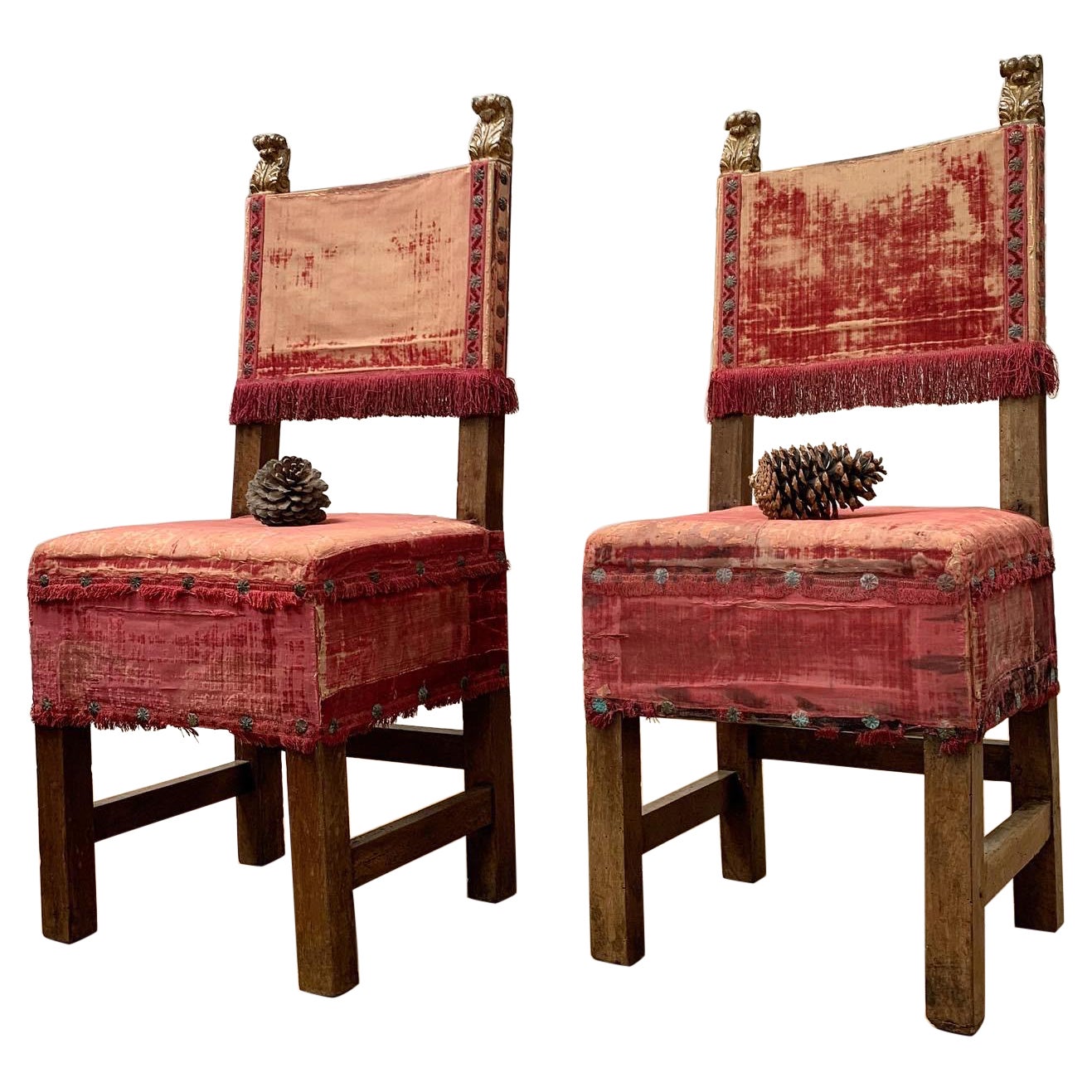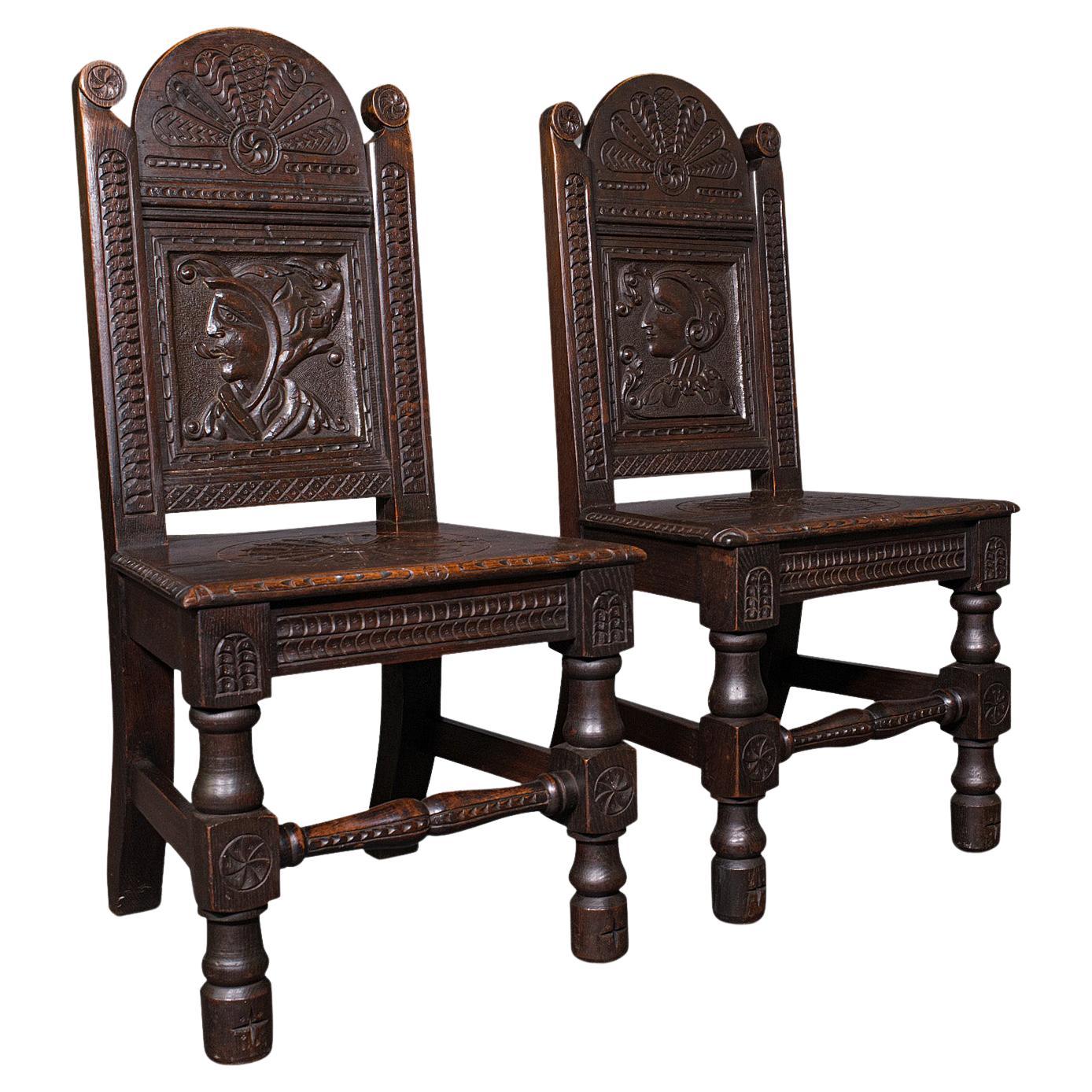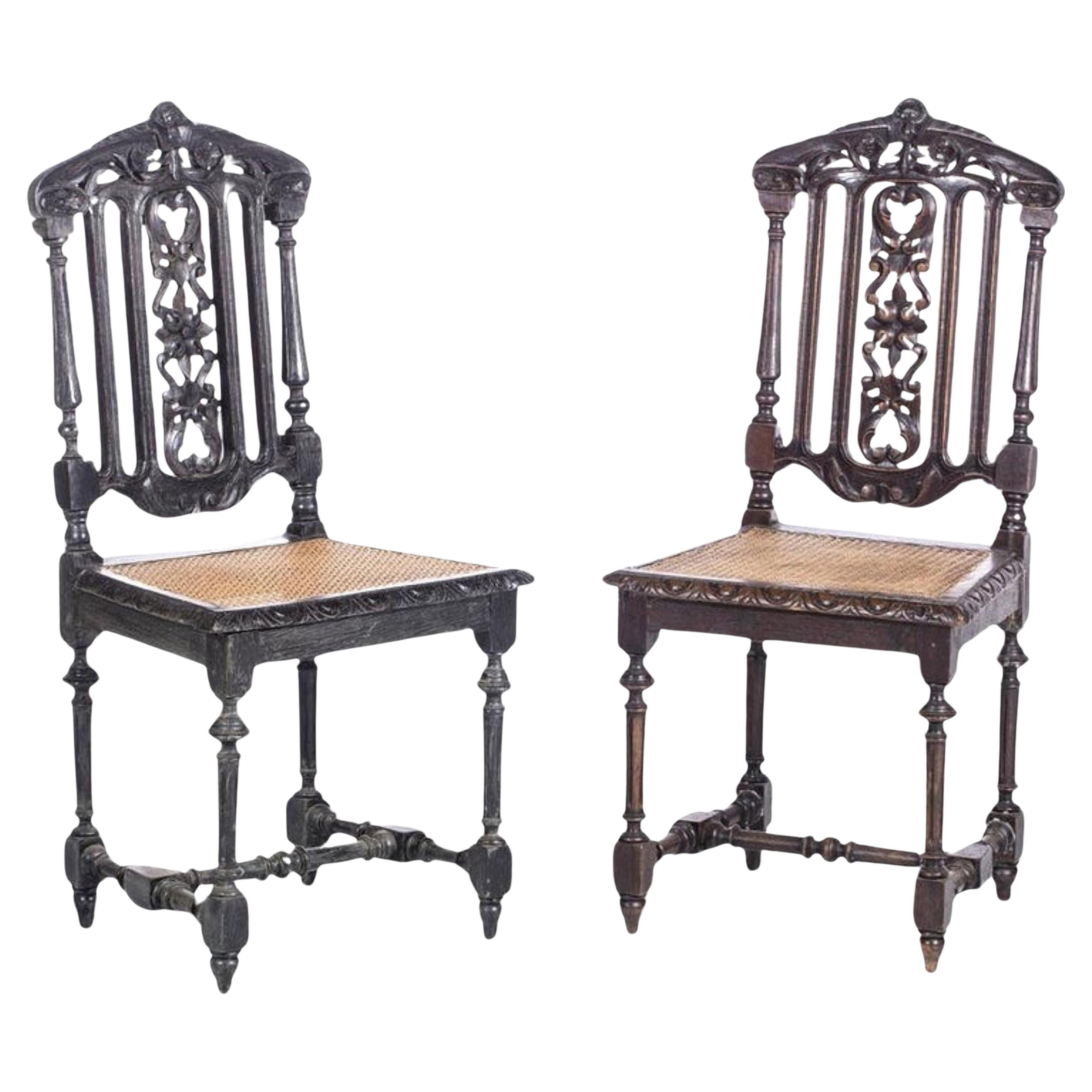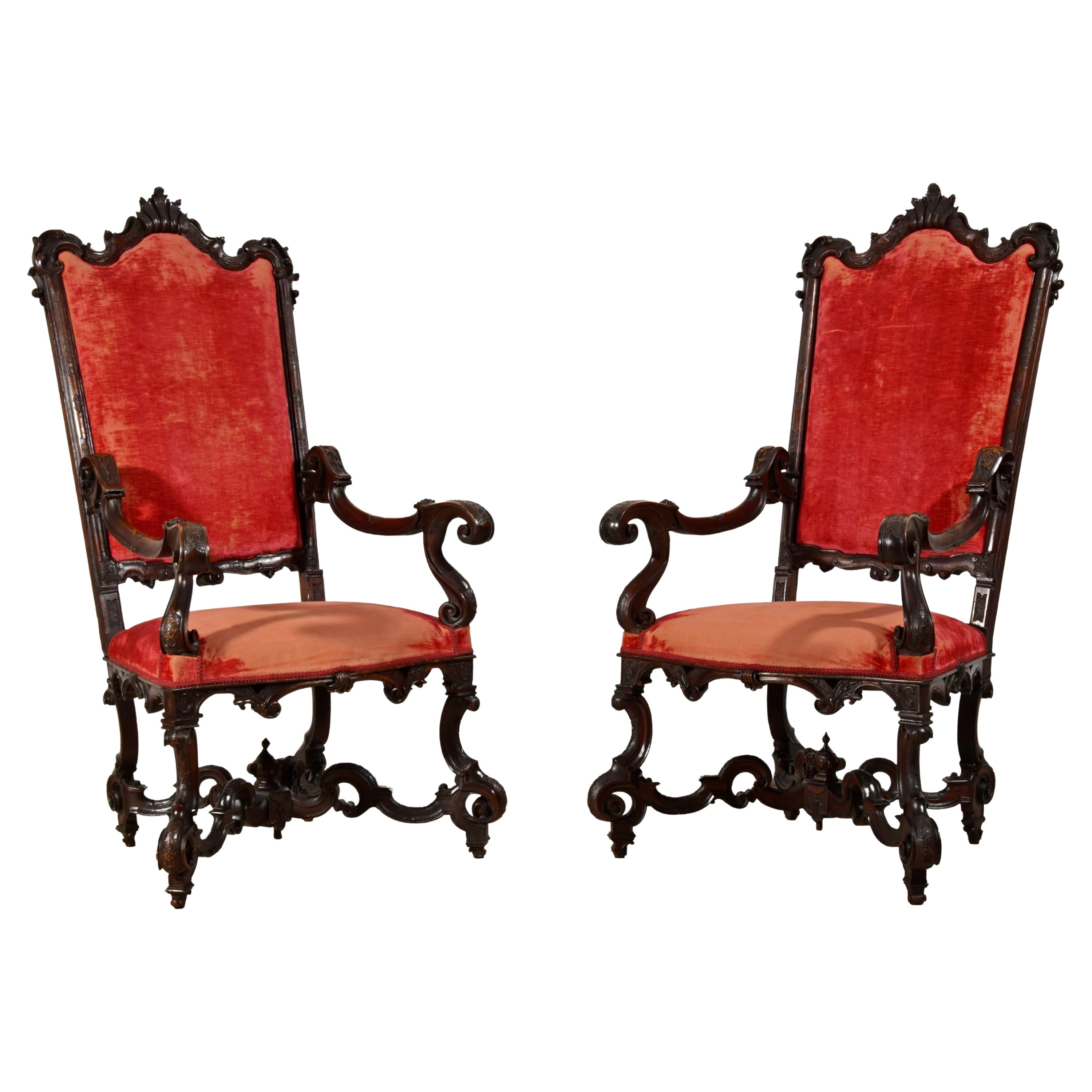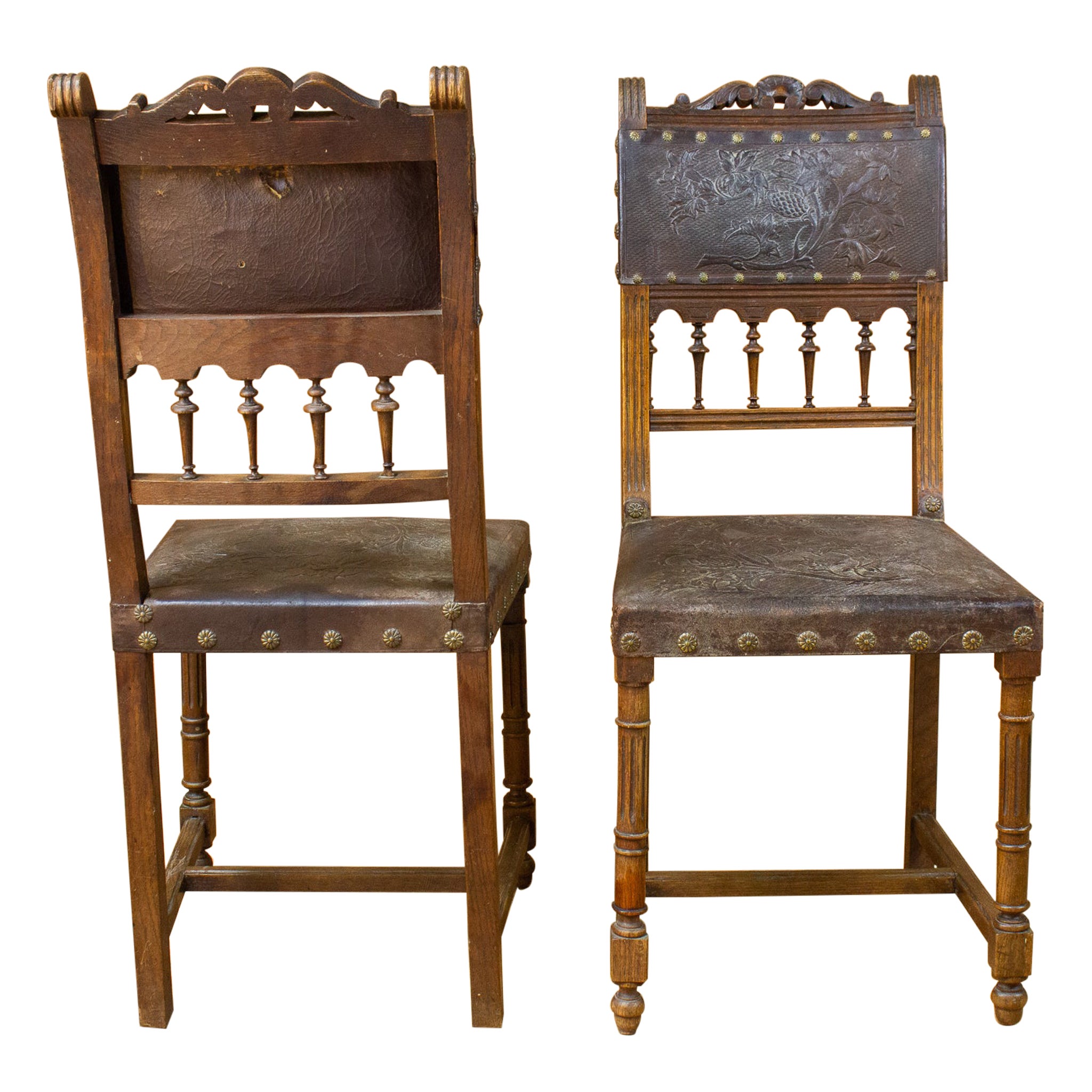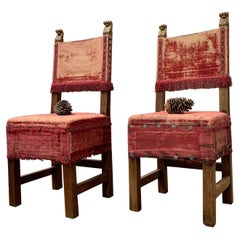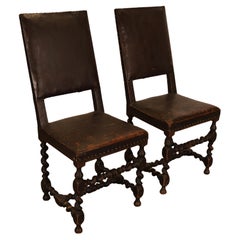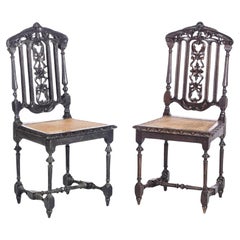Items Similar to Pair of Wooden Chairs, Lombardy, 17th Century
Want more images or videos?
Request additional images or videos from the seller
1 of 6
Pair of Wooden Chairs, Lombardy, 17th Century
$9,311.67per set
£6,862.66per set
€7,800per set
CA$12,745.62per set
A$14,275.77per set
CHF 7,428.16per set
MX$173,378.26per set
NOK 94,170.18per set
SEK 88,856.58per set
DKK 59,363.09per set
Shipping
Retrieving quote...The 1stDibs Promise:
Authenticity Guarantee,
Money-Back Guarantee,
24-Hour Cancellation
About the Item
Pair of beautifully carved wooden chairs
Lombardy, first half of 17th century
H 86 x L 48 x P 43 cm
Pair of “da balia” (nanny) chairs. The backrest is decorated with winged mythological animals with mermaid tails holding a coat of arms.
The chairs are stamped on the back.
- Dimensions:Height: 33.86 in (86 cm)Width: 18.9 in (48 cm)Depth: 16.93 in (43 cm)
- Sold As:Set of 2
- Style:Renaissance (In the Style Of)
- Materials and Techniques:
- Place of Origin:
- Period:
- Date of Manufacture:17th Century
- Condition:Replacements made: The wooden footrest has been changed by a professional cabinetmaker. The velvet and the cushions are modern. Wear consistent with age and use.
- Seller Location:Bruxelles, BE
- Reference Number:1stDibs: LU6666230744912
About the Seller
5.0
Vetted Professional Seller
Every seller passes strict standards for authenticity and reliability
1stDibs seller since 2022
15 sales on 1stDibs
Typical response time: 2 hours
- ShippingRetrieving quote...Shipping from: Bruxelles, Belgium
- Return Policy
Authenticity Guarantee
In the unlikely event there’s an issue with an item’s authenticity, contact us within 1 year for a full refund. DetailsMoney-Back Guarantee
If your item is not as described, is damaged in transit, or does not arrive, contact us within 7 days for a full refund. Details24-Hour Cancellation
You have a 24-hour grace period in which to reconsider your purchase, with no questions asked.Vetted Professional Sellers
Our world-class sellers must adhere to strict standards for service and quality, maintaining the integrity of our listings.Price-Match Guarantee
If you find that a seller listed the same item for a lower price elsewhere, we’ll match it.Trusted Global Delivery
Our best-in-class carrier network provides specialized shipping options worldwide, including custom delivery.More From This Seller
View AllWalnut Table "a lira" - Tuscany, 17th century
Located in Bruxelles, BE
Walnut Table "a lira" - Tuscany, XVII century
Table “a lira”
Walnut
Tuscany, XVIIth century
71 X 90 X 49,5 cm
Beautiful patina.
Category
Antique 17th Century Italian Renaissance Desks and Writing Tables
Materials
Walnut
17th century wood and black marble table - North of Italy
Located in Bruxelles, BE
Walnut and marble table
North of Italy, 17th century
Wood and black marble
H 80,5 x L 114 x P 58 cm
This elegant table features a one single solid marble top directly mounted on f...
Category
Antique 17th Century Italian Baroque Side Tables
Materials
Marble
Pair of Safari Chair « Diana » by Karin Mobring
Located in Bruxelles, BE
Karin Mobring
Safari chair « Diana »
1970
Leather, linen, Pine
70 x 63 x 60 cm
The frame is made in wood and upholdery is made in Swedish ecru linen.
These Safari chairs are a design by Karin Mobring and they were produced in the 70s. This model is also called the "Diana Chair...
Category
Vintage 1970s Swedish Scandinavian Modern Chairs
Materials
Leather, Linen, Wood
$3,462 / set
renaissance wooden candelabrum and painted cross - Umbria, 16th century
Located in Bruxelles, BE
Base of a carved wooden candelabrum, polychrome and gilded; cross painted on both sides.
Umbria or Tuscany, 16th century
136 x 43,5 x 30 cm
(The cross and the base of the candelabrum were later assembled)
The base of the candelabrum is intricately carved and adorned with polychrome and gilded finishes. The shafts take on the shape of balusters reminiscent of ancient columns, feature ornate foliage decorations, garlands and winged cherub faces. The feet are crafted in the likeness of lion paws. The base is further embellished with depictions of four saint martyrs, among them Saint Barbara and Saint Catherine of Alexandria. The plasticity of the figures, outlined with strong contour lines, the clear and vibrant colors, are stylistic elements linked to the Umbrian tradition of the sixteenth century.The precisely defined and elegant drawing, along with the clear color palette applied with refined chiaroscuro modulations, became the signature of a style that would leave a lasting mark on the era to come. This is exemplified by a preference for vibrant, multicolored images, accentuated in this case by the use of red and pink in the saint's attire.
A notable addition, introduced later, is a polylobed cross painted on both sides. On one side, the Crucifixion is vividly portrayed:The treatment of the corpus itself is in line with High Medieval practice, emphasizing pathos by showing Jesus dead, his arms sagging from the weight of the body. The upper section displaying a pelican pecks at her breast to feed her young with her own blood; a symbol of the sacrifice of Christ on the cross whose body and blood similarly nourishes the celebrant during Mass.
The lower part depicts Golgotha. On the reverse side, the Resurrection is artistically presented in a Renaissance iconography, reminiscent of the renowned composition painted by Piero della Francesca, now housed in the Civic Museum of Sansepolcro. In terms of composition, with the frontal depiction of Christ holding the banner, this motif became particularly widespread in central Italy, spanning from Tuscany to Umbria throughout the 16th century..
The double-sided construction suggests that it may also have been carried in liturgical processions. In Umbria from the 14th century, the use of portable crosses painted on both sides had become a widespread practice, aimed at satisfying the monastic clientele that had significantly increased following the establishment of new religious communities.
The earliest surviving Tuscan painted crucifix represent Christ as Christus Triumphans, or the “Triumphant Christ” with his head up and eyes open. This form was supplanted in the 13th century with the Christus Patiens, or “Suffering Christ” type who is shown often with his head fallen on his shoulder and his eyes closed, as In our cross. The iconography of the suffering Christ appears to have developed out of a new interest in Christ’s human nature, the development of the feast of Corpus Christi and with increased importance given to the Eucharist. The process of humanizing the figure of Christ reaches its peak with the abandonment of all the previous expressive conventions in favor of more realistic details we can observe in this Crucifix, such as the swollen belly, the arms stretched to the limit of muscle tearing, the body falling heavily forward, the abundant blood on
the wounds, and the cross firmly embedded in the rock of Calvary.
It's worth noting that Renaissance candelabra...
Category
Antique 16th Century Italian Renaissance Figurative Sculptures
Materials
Wood, Giltwood
Pair of Gothic Columns - Italy, 14th-15th century
Located in Bruxelles, BE
Rare pair of Gothic Columns - Olivetani
Marble
Italy, 14th - 15th century
Heraldic shields on the capitals of the Order of the Olivetani
H 220 et 225 cm x W 25 x D 25 cm
H 86 2/3 & 8...
Category
Antique 15th Century and Earlier Italian Gothic Architectural Elements
Materials
Marble
$77,597 / set
double capital - french, end of 13th century
Located in Bruxelles, BE
Double capital with hook decorations
Grey stone
France, 13th century
Reduced—cut in the back in modern times
H 22 x L 41 x P 20 cm
'Hook' is the name given today to these ornamen...
Category
Antique 15th Century and Earlier French Medieval Architectural Elements
Materials
Stone
You May Also Like
Pair of Seventeenth Century Italian Chairs
Located in London, GB
A sumptuous pair of seventeenth century Italian walnut chairs, the backs surmounted by carved and gilt finials with red velvet seats and backs, wit...
Category
Antique 17th Century Italian Renaissance Chairs
Materials
Velvet
$4,843 / set
Pair of Antique Venetian Court Chairs, Italian, Oak, Decorative Seat, Victorian
Located in Hele, Devon, GB
This is a pair of antique Venetian court chairs. An Italian, hand-carved oak decorative seat, dating to the Victorian period, circa 1890.
Fascinati...
Category
Antique Late 19th Century Italian Side Chairs
Materials
Oak
Pair of Baroque Chairs, 18th Century
Located in Ljungby, SE
Two Baroque chairs made in Stockholm around the year 1700. The chairs are upholstered in antique leather and feature turned legs and an H-stretcher.
Category
Antique 18th Century Swedish Baroque Chairs
Materials
Leather
$4,000 / set
Pair of Romantic Chairs, 19th Century
Located in Madrid, ES
Pair of Romantic chairs
19th century
In carved oak wood, hollow back, cane seats. Decorated with plant motifs.
Signs of use.
Dimensions.: 101 x 47 x 42 cm.
Category
Antique 19th Century Portuguese Baroque Chairs
Materials
Wood
$1,193 / set
19th Century Pair of Large Venetian Wood Armchairs
Located in IT
19th century Pair of large Venetian wood armchairs.
This important pair of very large armchairs was made in Venezia (Italy) in the first 19th century, Louis XIV-Regency.
The armc...
Category
Antique Early 19th Century Italian Regency Armchairs
Materials
Wood
Pair of Chairs Neo- Renaissance or Henri II Style in Wood and Leather 19th
Located in Beuzevillette, FR
Elegant pair of Neo-Renaissance or Henri II style chairs in leather and wood dating from the 19th century. The wooden structure is carved with flutes and volutes. Pieces of leather f...
Category
Antique 19th Century French Renaissance Revival Chairs
Materials
Leather, Wood
